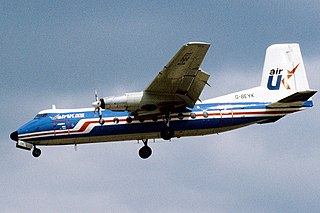
A turboprop is a turbine engine that drives an aircraft propeller.

The Saab 2000 is a twin-engined high-speed turboprop airliner built by Swedish aircraft manufacturer Saab. It is designed to carry 50–58 passengers and able to cruise at a maximum speed of 685 km/h (370 kn). Production took place in Linköping, Sweden. The Saab 2000 first flew in March 1992 and was certified in 1994. The last aircraft was delivered in April 1999, a total of 63 aircraft being built. As of June 2023, 31 total Saab 2000s were in either airline or military service.
The Lockheed Model 10 Electra is an American twin-engined, all-metal monoplane airliner developed by the Lockheed Aircraft Corporation, which was produced primarily in the 1930s to compete with the Boeing 247 and Douglas DC-2. The type gained considerable fame as one was flown by Amelia Earhart and Fred Noonan on their ill-fated around-the-world expedition in 1937.

The Avro 691 Lancastrian was a British and Canadian passenger and mail transport aircraft of the 1940s and 1950s developed from the Avro Lancaster heavy bomber. The Lancastrian was basically a modified Lancaster bomber without armour or armament and with the gun turrets replaced by streamlined metal fairings, including a new nose section. The initial batch was converted directly from Lancasters; later batches were new builds.

The Handley Page HP.81 Hermes was a civilian airliner designed and produced by the British aircraft manufacturer Handley Page.

The British Aerospace Jetstream 41 is a turboprop-powered feederliner and regional airliner, designed by British Aerospace as a stretched version of the popular Jetstream 31. Intended to compete directly with 30-seat aircraft like the Embraer Brasilia, Dornier 328 and Saab 340, the new design eventually accommodated 29 passengers in a two-by-one arrangement like the Jetstream 31. Eastern Airways of the UK is the biggest operator of Jetstream 41s in the world, with 14 in the fleet.

The Pilatus PC-6 Porter is a single-engined STOL utility aircraft designed by Pilatus Aircraft of Switzerland. First flown in 1959, the PC-6 was produced at Pilatus Flugzeugwerke in Stans, Switzerland. It has been built in both piston engine- and turboprop-powered versions, and was produced under licence for a time by Fairchild Hiller in the United States. After 604 deliveries in 63 years, Pilatus ended production in 2022.

The Mitsubishi MU-2 is a Japanese high-wing, twin-engine turboprop aircraft with a pressurized cabin manufactured by Mitsubishi Heavy Industries. It made its maiden flight in September 1963 and was produced until 1986. It is one of postwar Japan's most successful aircraft, with 704 manufactured in Japan and San Angelo, Texas, in the United States.

The Handley Page Dart Herald is a 1950s British turboprop passenger aircraft.

The Honeywell TPE331 is a turboprop engine. It was designed in the 1950s by Garrett AiResearch, and produced since 1999 by successor Honeywell Aerospace. The engine's power output ranges from 575 to 1,650 shaft horsepower.

The Aérospatiale N 262 is a French twin-turboprop high-wing airliner built first by Nord Aviation. The aircraft was also known as the Nord 262.

The Short L.17 Scylla was a British four-engined 39-seat biplane airliner designed and built by Short Brothers at the request of Imperial Airways to supplement the Handley Page H.P.42 fleet already in service after Handley Page quoted an excessive price for two additional H.P.42s. They were ordered in 1933.

The Piasecki VZ-8 Airgeep was a prototype vertical takeoff and landing (VTOL) aircraft developed by Piasecki Aircraft. The Airgeep was developed to fulfill a U.S. Army Transportation Research Command contract for a flying jeep in 1957. The flying jeep was envisioned to be smaller and easier to fly than a helicopter.

The Turbomeca Astazou is a highly successful series of turboprop and turboshaft engines, first run in 1957. The original version weighed 110 kg (243 lb) and developed 240 kW (320 shp) at 40,000 rpm. It was admitted for aviation service on May 29, 1961, after a 150-hour test run. The main developing engineer was G. Sporer. It was named after two summits of the Pyrenees.

The Handley Page (Reading) H.P.R.1 Marathon was a British four-engined civil transport aircraft, capable of seating up to 20 passengers. It was designed by Miles Aircraft Limited and largely manufactured by Handley Page (Reading) Limited at Woodley Aerodrome, Reading, England.
The Dassault M.D.320 Hirondelle was a French 14-seat utility transport aircraft of the 1960s, designed and built by Dassault Aviation, in prototype form only.
The FMA IA.62 was a military trainer aircraft under development in Argentina in the late 1970s.

The Potez 840 was a 1960s French four-engined 18-passenger executive monoplane, the last aircraft to use the Potez name.

The British Aerospace Jetstream is a small twin turboprop airliner, with a pressurised fuselage, developed as the Jetstream 31 from the earlier Handley Page Jetstream. A larger version of the Jetstream was also manufactured, the British Aerospace Jetstream 41.

The Short SC.7 Skyvan is a British 19-seat twin-turboprop aircraft manufactured by Short Brothers of Belfast, Northern Ireland. It is used mainly for short-haul freight and skydiving.




















